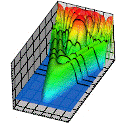Department of Physics and Astronomy: Publications and Other Research
Date of this Version
9-11-2013
Citation
PHYSICAL REVIEW A 88, 033410 (2013); DOI: 10.1103/PhysRevA.88.033410
Abstract
We develop a general theoretical framework for the analytical description of the interaction of a model diatomic molecular system with an intense, arbitrarily polarized monochromatic laser field. The model molecule comprises an electron in the field of two zero-range potentials separated by the internuclear distance. This model has an exact analytical solution within the theoretical framework of the quasistationary quasienergy (Floquet) approach. In addition to the development of this general framework, we also present a detailed analysis of the weak-field limit, within which we obtain both the frequency-dependent polarizability and the angle-resolved photodetachment cross section for the model system. These fundamental properties are analyzed for both homonuclear and heteronuclear molecular systems in a linearly polarized laser field, for both ground and excited electronic states, and for arbitrary orientation of the molecular axis relative to the polarization vector of the laser field. The analytical expressions for the polarizability and angle-resolved photoelectron spectra exhibit characteristic double-slit interference patterns, allowing one to study their dependence on the parameters of the problem beyond the level of the Born approximation.


Comments
©2013 American Physical Society. Used by permission.